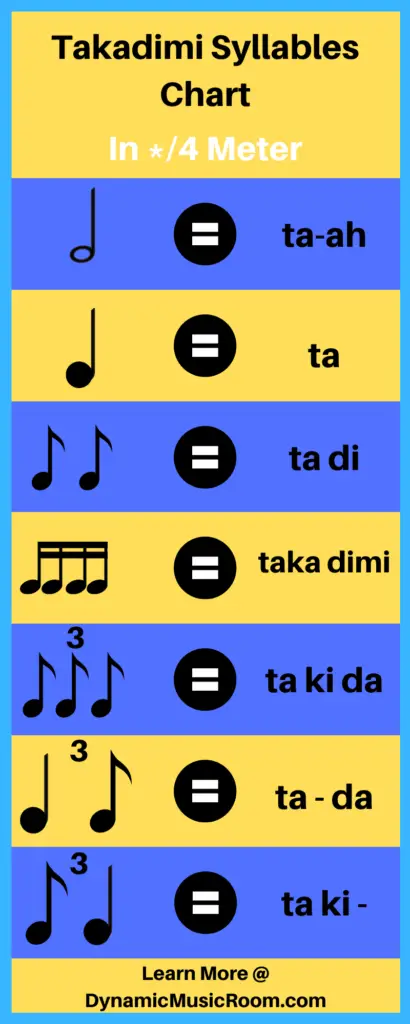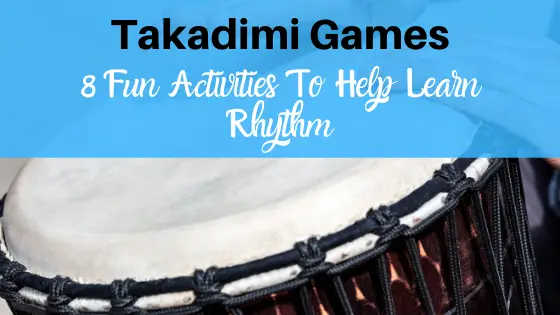Do you like to use takadimi with your class, but you’re struggling to keep it fun and interesting?
It sounds like you need some takadimi games.
Takadimi games are a great way to reinforce learning with this beat-function rhythm system. 8 of my favorite takadimi games are:
- Rhythm train
- King of the mountain
- Rhythm Soup
- Rhythm Jeopardy
- Sing-Say-Think
- Disappearing Rhythms
- I have, Who has?
- Rhythm rally robin
Read on for more details about these games and the takadimi rhythm syllables.
Table of Contents
Takadimi System
Takadimi borrows rhythm sounds from South Indian classical music. This system is a well-known beat-function system, which means the syllables are based on the rhythm values getting the beat.
For example, a note landing on the beat itself will always use the syllable “ta” regardless of how long it is. A note landing halfway between the beat will always be called “di”.
Here is a brief description of the syllables if they were in 4/4 meter:
- Quarter note = ta
- 2 eight notes = tadi
- 4 sixteenth notes = takadimi
- 1 eighth note-2 sixteenth notes = tadimi
- 2 sixteenth notes-1 eighth note = takadi
- 3 triplets = takida
- 6 sixteenth note triplets = tavakididama
Note: All rhythms are assuming they start on the beat.
On a personal note, I used takadimi in my undergraduate music program and greatly enjoyed using it. I found it quite helpful.
I even checked out this You Can Ta Ka Di Mi! book from the library to improve myself as a musician. It’s pretty affordable if you want to understand the system better and improve your awareness of rhythm and beat.

8 Fun Takadimi Games
In this section, I’ll go over 8 of my favorite rhythm games. These can be takadimi games, but they also work with any rhythm syllable system such as:
- Kodaly Counting (Ta ti ti)
- Orff Rhythm
- Gordon/Froseth
- 1 E And A
- French Time Names
#1 Rhythm Train
Rhythm train is a game kids love to play. It allows you to easily assess their individual understanding of how rhythms work.
First, students think of 4 beat rhythm (or 8 if you want) using the concepts you’re working on.
Each student then says their rhythm one at a time to the steady beat. The goal is for all students to say their rhythm in one long stream to the beat.
You may find it helpful to play the steady beat on a drum while they say it.
I always tell them they have three “wobbles” or mistakes as a class before the rhythm train crashes. The get wobbles by:
- Saying the rhythm to an unsteady beat
- Forgetting your rhythm
- Performing a rhythm incorrectly
- Making a rhythm not in the correct amount of beats
I’m usually pretty easy the first couple times we play, but then I get pickier.
#2 King Of The Mountain
King of the Mountain is a game I first saw as a math activity in a general classroom. Then, I found a number of music teachers do it with rhythms and pitches as well.
All you need is a series of flashcards using the concepts you want to practice.
Two kids compete at one time seeing who can correctly say the rhythm on a flashcard first. The one who wins stays on as King of the Mountain while the other goes to sit down.
Then, you repeat with the next student until all have gone. The last one remaining is the King (or Queen) of the Mountain.
This can also be done as a center if you’ve already taught and played this game with the students as a whole.
#3 Rhythm Soup
To play this game, you need bean bags (I like these Prextex ones) and a bucket or drum to toss them into.
You’re creating a rhythm soup by tossing in different rhythms the students create. Basically, students each get a turn creating/saying a rhythm and tossing the bean bag into the drum/bucket.
For a challenge, you can give student parameters before they toss such as these:
- Must start with a specific note
- Must end with a specific note
- Use so-and-so types of rhythms
- Can’t repeat ones that have already been said
- Must start with the one the last rhythm ended with
As with many of these, once this game has been taught, you can use it as a center and to give you some formative assessment.
#4 Rhythm Jeopardy
Rhythm jeopardy is just like regular jeopardy, but all the answers have to do with rhythm. I’m usually pretty low-tech and just make up my own to stick on my white board.
But I have used this free Jeopardy builder before. You can upload images too for reading as well.
The trickiest part is coming up with categories, so here are the ones I use:
- Read the rhythm
- Decode the rhythm
- Name that rhythm
- Mystery song
- Improvise rhythm
Here’s a brief breakdown of the categories.
Read the rhythm – Students read the rhythm in takadimi. Enough said.
Decode the rhythm – Students say the rhythm you play.
Name that rhythm – Show a single rhythm note value. Students say its name.
Mystery song – Show a clip of a rhythm from a well-known song they’ve done in class. Students must guess the name of the song.
Improvise rhythm – Students must improvise the missing beats and end at the right spot on the rhythm you put at the end.
#5 Sing-Say-Think
To set up for this rhythm, you’ll need a longer rhythm for the students to read (consider combining these 4 beat rhythm patterns) (consider combining these 4 beat rhythm patterns). If you make or borrow one that’s at least 16 beats, it’ll do just fine.
Pro-tip: Pick the rhythm of a well-known folk song.
First, you need to have the students able to perform this with confidence. Then, you challenge them with this activity.
As they perform the rhythm, you strike a triangle or other instrument. At this signal, they switch between saying the takadimi syllables to thinking the rhythm internally.
When you strike again, they switch to using takadimi again.
At this point, the game is just “Say-Think.” You make this even harder by adding the “Sing.”
If you used a song as the basis for the rhythm, then you can do this version of the game. It’s the same, except every time you hit the triangle they switch between Sing⇾Say⇾Think.
Note: Students love to be in charge of the triangle, but be careful to teach them not to strike too often or it becomes impossible.
#6 Disappearing Rhythms
For this game, you’ll also need a longer rhythm using values they know. First, have students clap and say the rhythm with their takadimi syllables.
Then, cover up a rhythm and have them perform the rhythm. They think the covered up note internally.
Repeat each time they’re successful until the whole rhythm is covered, and the students think the whole thing internally.
As an alternative, you could have them say the covered up rhythms and assess their memorization skills yourself.
If you’re low-tech, just cover the rhythms up with sticky notes. You could also make boxes to cover the rhythms with on PowerPoint.
#7 I Have, Who Has?
I have, Who has? Is a fun game to game with rhythms, but it can take some work to set up. Basically, everyone gets a flashcard with an “I have” rhythm and a “Who has?” rhythm.
One person starts by reading their rhythms with the sentences.
Example: “I have ta ta tadi ta. Who has tadi tadi ta ta?”
Someone else has the second rhythm on their “I have” part and then reads their cards. It continues around the room until all have gone.
This requires serious planning ahead with cards if you try it on your own. Or you can just buy it from Teacher Pay Teacher.
#8 Rhythm Rally Robin
Students love this cooperative learning activity. It’s played with the following steps.
- Students move around the room silently until the music stops.
- They partner up with the nearest person to them.
- The whole class takes 5 seconds to think of several rhythm patterns.
- Partner 1 (who you pick) says one rhythm.
- Partner 2 says one rhythm.
- Repeat until the Teacher give the quiet signal.
- Students thank each other for sharing.
- Music starts and the activity repeats with different partners.
As a social activity, this helps those who learn best through the social intelligences. As such, this is also a great tool for differentiation.
This activity doesn’t require much teacher talk and helps you save your voice.
Conclusion
I hope you find these takadimi games helpful. I picked ones you can hopefully use in your classroom right away.
Which one is your favorite? Let us know below!

